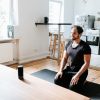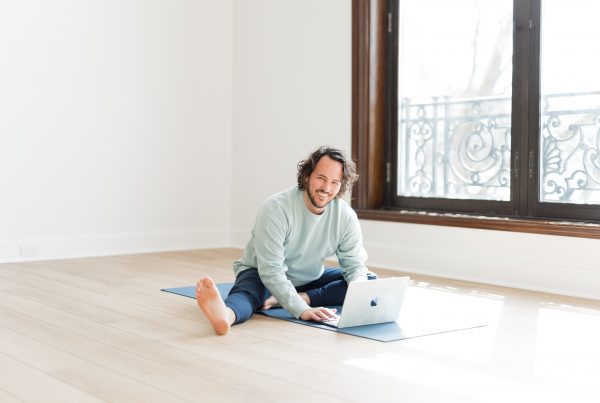
In this digital age, with an abundance of online resources at our fingertips, the question comes up over and over again: Can you truly learn yoga online? Almost anyone can open up their laptop and search for yoga classes, yoga tutorials, and almost anything else that falls under the umbrella of yoga. It can be really beautiful to have so much information at our fingertips, but it can also be a little overwhelming.
When it comes to learning yoga online, lots of people are excited to practice at home and learn from the comfort of their own home. There are also lots of accessible resources like YouTube, for example, that offer multiple classes and lessons. This age of online yoga has also come with a lot of options for class length. There are options for full length, 60-90 minute classes, as well as 30 minute yoga classes and so much more.
Is it possible to learn yoga at home?
The beautiful thing about yoga is that all you really need is a mat. Of course, using props is incredibly helpful and may help support the practice, but they’re not always necessary. This means that you can really practice yoga anywhere, whether it’s at home or on a business trip or a family vacation. At the core of yoga, all you really need is your body and your breath.
Learning yoga at home certainly has advantages and disadvantages. Some advantages include convenience, personal pacing, and the option to practice according to what you specifically need and want that day. Learning at home removes the stress behind getting to a studio on time, worrying about being late, worrying about the teacher ending late, and taking part in a class that has a focus you may not be too excited for.
When you choose to learn at home, you are in full control. This is especially helpful for yoga teachers or advanced practitioners who have strong body awareness and know their limits. It’s a great way for people with a consistent practice to stay consistent and committed. Practicing at home also allows beginners to take a bit more time figuring out the set-up of a pose and it gives them the ability to pause or rewind a recorded class.
Like anything with tons of advantages, there are also a few disadvantages of practicing at home. We’ve definitely come a long way with technology and live classes can offer real-time feedback. However, if someone is just watching a recorded video, they may have some immediate questions. Without a teacher physically present, there’s potential for misalignment or misunderstanding the poses. A person who isn’t aware of how to modify poses that don’t feel right for them or a person who is injured and lacking information on how to modify common poses would certainly be at a disadvantage.
Sometimes, people also need the accountability of physically showing up to a class and having a teacher see them and tell them they’ll see them the next week. It can be challenging to actually stick to a schedule that you set for yourself at home.
Learning yoga online is definitely possible, especially now that we have so much equipment, technology, and various ways to communicate to each other in real-time.
Is it okay to learn yoga from YouTube?
YouTube, with its gigantic library of yoga tutorials and classes, is the go-to for many aspiring yogis seeking knowledge and clarity around this ancient practice. The pros and cons of learning yoga from home are also present when it comes to learning yoga from YouTube. Sometimes a lot of information can be too much information. There are tons of styles of yoga to choose from, and if you’re not sure what you like or what your body and mind are seeking, it can be a little overwhelming. From Hatha to Ashtanga, Yin to Kundalini, there’s a video for every style and level. This variety can help you discover what resonates with you, but if you try a class and don’t vibe with it, there’s a chance you might just write-off yoga forever, which is certainly a con!
YouTube yoga classes host a lot of offerings from expert teachers in the many realms of the yoga practice (meditation, pranayama, vinyasa, etc.) Many renowned yoga instructors, studios, and teacher trainings have their channels, with top-tier instruction for free or at a fraction of studio prices. If you haven’t already checked out our YouTube channel, we invite you to do so today: YogaRenew YouTube Channel
Using YouTube can help you get a taste for a teacher or studio and see what their teaching is like before you commit to a class pack, subscription, or training. Teachers love to share important information about alignment and modifications because there isn’t always time to unpack those things and break them down in a live, online, or in-person group class.
Although you won’t be getting live feedback in the moment, you can use YouTube to help you understand different styles of yoga, poses, modifications for poses, and even explore other classes in meditation or pranayama. YouTube is a great platform to help you begin to expand your knowledge of yoga and everything that comes with the teachings. It’s also a great source to use for when you want to explore topics in yoga philosophy and the subtle body.
If you decide to learn from YouTube, choose reputable instructors and schools. Find out their credentials, read reviews, and listen to your body. If a pose feels off, make sure you tune into your inner wisdom and resist pushing yourself or going too far.
Is 30 minutes of yoga a day enough?
The answer largely depends on you! The answer to a lot of questions about how something should feel or how much of something you should do usually always comes back to you checking in with how you’re doing and how you’re feeling. One of the goals of yoga is to heighten self-awareness so you can become better at figuring out what you need.
If your goal is to move your body, center your mind, and clear your thoughts, then 30 minutes can be sufficient. 30 minutes is actually a nice amount of time to give to yourself if you plan to practice somewhat daily. It’s a timeframe that can be worked into most busy days and it’s just enough time to really sink into yourself and check in with yourself.
If you’re looking to gain more flexibility, strength, or master advanced poses, a more extended session might be beneficial. There are lots of poses that require more of a warm-up and more awareness around grounding, lengthening, and building certain physical patterns before moving into a deeper pose. In this case, 60 minutes is often ideal, and 90 minutes can be even better.
Consistency is key in yoga. It’s often more productive and practical for some people to practice for 30 minutes daily than to fit in a 60-90 minute class a few times a week. Over time, those daily half-hour practices will lead to noticeable improvements in flexibility, strength, and mental clarity.
Let’s embrace the online world!
This digital world we have access to offers accessibility, diversity, and flexibility. However, like any tool, its efficacy depends on how you use it. Make sure you choose reputable sources, maintain self-awareness, and prioritize safety. You can also consider supplementing with occasional in-person classes or workshops for feedback.
Yoga is a journey of self-discovery, and online resources can be valuable companions on the path. Embrace the online world with mindfulness, and your practice can flourish anywhere. Online yoga is something a lot of us may have resisted at first, but it’s proven to be helpful for so many people across the globe!
With the online movement growing bigger and bigger every year, it’s a source to embrace. There are so many yoga teachers using the digital platform as a tool to help get their offerings out to more and more people. Almost everyone can practice yoga in some way and it’s been beautiful to see it become so accessible to people who otherwise wouldn’t be able to try it.
If we can elevate the positive things about the digital world, we can build on that positive. It’ll only keep getting better, more accurate, and hopefully serve those who continue to need it.
Like this blog? Drop your email below to stay in the know with the latest in yoga trends, education & community!










